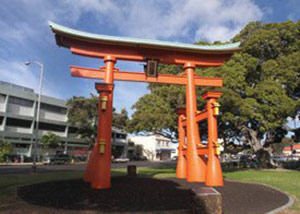 Moiliili Part 1
Moiliili Part 1
Although Moiliili?s cultural identity has been diminished by decades of redevelopment, remnants and reminders of its colorful, multi-ethnic history can be found throughout the large urban neighborhood.
Organizations such as the Moiliili Community Center, the Japanese Chamber of Commerce, and the Japanese Cultural Center, as well as urban historians, have perpetuated the dynamic of a cohesive community that hodgepodge development has failed to fracture.
A typical Moiliili block might include highrises and town-homes interspersed with 80 year old cottages, chain stores, spe-cialty shops, contemporary boutiques, ?mom and pop? markets, ethnic restaurants, fast food outlets, office buildings, and banks.
?This diversity is what makes Moiliili interesting,? said Moiliili Community Center Executive Director Rebecca Ryan. ?We also have a diverse population mix?old timers and families who have lived in the same place for generations and new residents attracted by the convenience of the neighborhood, its many public and private schools, and proximity of the University of Hawaii?s Manoa Campus.?
The Community Center of fers educational and recreational programs for children and adults. Its facilities are available to social and service groups for meetings, cultural programs, and classes. The Center is a sponsor of the Moili-ili Summer Festival presented in July with additional support from the Moiliili Hongwanji Mission and the Japanese Cultural Center of Hawaii, which has also become a major community resource since it opened its doors in 1992.
Although Moiliili is densely developed it incorporates large pockets of open space. The Hon-olulu Department of Parks and Recreation?s 13.98 Ala Wai Community Park and Community Garden, the 15.70 acre Ala Wai Neighborhood Park, both with recreational facilities and canoe storage, and the Ala Wai Promenade extend along the makai boundary of Moiliili. The Old Stadium Park at King and Isenberg was kept in open space after the demolition of the Honolulu Stadium in 1976. The Triangle Park with its tori gate marks the entrance to Moiliili.
Recently Longs Drugs opened its largest Oahu store on an adjacent site formerly occupied by the Star Market, one of many examples of the confidence of the business community in the future of the neighborhood. Adaptive reuse of existing buildings has become a trend with the effect of preserving the scale of older sectors of the neighbor-hood and enriching the overall fabric of the built environment. Vintage homes have been re-modeled and converted into offices. Four years ago Home-works Construction purchased a 17,200 square foot site occupied by two 60 year old buildings to build its new offices and showroom rather than move out of town to an industrial area. The total remodeling of the building fronting South Beretania enhanced the streetscape and elevated the desirability of the area. The venerable Willows Restaurant on Hausten Street in the heart of Moiliili was saved from extinction by a consortium of business people who recog-nized its historical and cultural importance to the community at large. After extensive restoration, it reopened in 1999.
Real estate values continue to escalate throughout Moiliili. Re-altor, developer, and real estate instructor Abe Lee, Broker in Charge of iProperties, has been active in the neighborhood over the years with sales, CPR developments, and condominium conversions. He noted that the company recently sold three Moiliili single family homes after a short time on the market, two at asking price. A five bedroom, five bath home home at 742 Hoawa sold for $1.225 million. A home at 748 Hoawa, with seven bedrooms and three baths, currently in escrow, was listed at $899,000. A three bedroom, one bath 62 year old home at 2470 Coyne Street, listed at $750,000 has also gone into escrow.
?Zoning in Moiliili is primarily residential, apartment, and business mixed use, which gives investors and developers a lot of flexibility and options. The area was zoned ag into the 1950s. I lived there as a kid and saw changes start taking place in the late 1960s when the first condos were built?then the townhome and highrise development gathered momentum in the 70s and 80s. Today, Moiliili is benefiting from the ?move back to town? trend?in spite of the density, it has retained its old Honolulu neighborhood atmosphere.?
Source: http://www.hawaiiislandhomes.com/history-among-the-highrises/
ups bachelor pad bachelor pad FedEx Green Coffee Bean Extract the voice oakland raiders
No comments:
Post a Comment
Note: Only a member of this blog may post a comment.